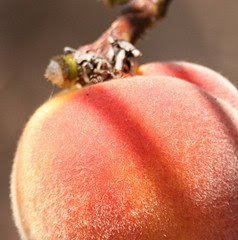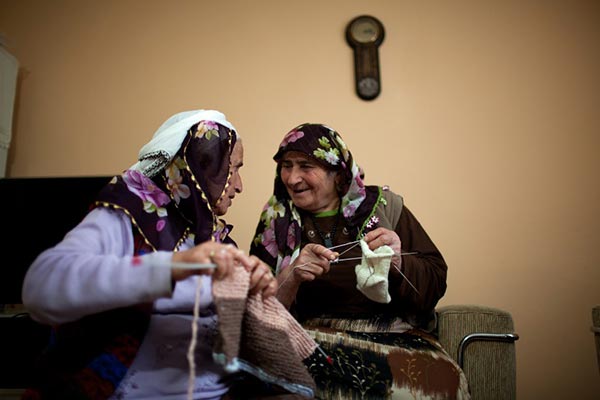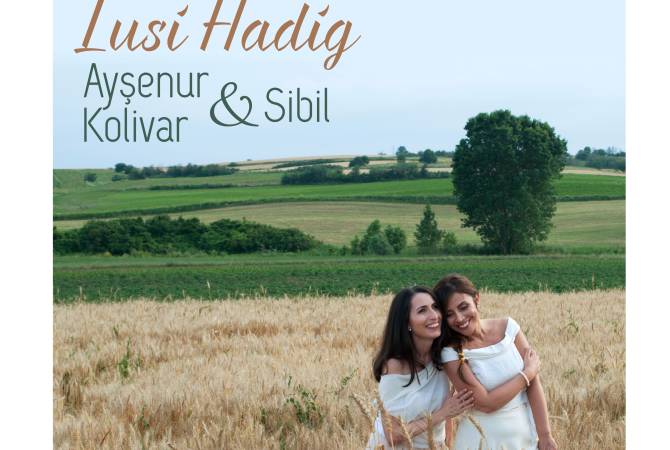The Bash-Hamshens: These People of Armenian Extraction Despise Armenians
Vahan Ishkhanyan
Who went and squealed to the police that some Armenians were staying at the Pension Fortuna? Maybe it was the old man I bumped into in Çinçiva, a village in the Rize district. Seeing me, he approached in high spirits. "Don't tell me we are strangers. Your face is very familiar," he laughed, shaking my hand. "Can't be," I said. "Please don't deceive me. We know each other but I can't remember where from," answered the old man. "No, this is my first time here. I'm from Armenia," I answered. The once smiling face turned stern and he retreated back into his house.
 Çinçiva: House on the cliffs Or was it the man who spotted us on the street, got out of the taxi, said hello, and cheerfully told us that he worked for an Armenian in Istanbul?
Çinçiva: House on the cliffs Or was it the man who spotted us on the street, got out of the taxi, said hello, and cheerfully told us that he worked for an Armenian in Istanbul? The police arrived at the Pension Fortuna and began to question Selçuk Güney What are Armenians doing here? The cops had grilled Selçuk once before, in the summer, after a group of musicians from Armenia had left. Selçuk was apprehensive and rarely spoke that entire day.
"Take it easy," said Hamshentsi Sheno back in Hopa. "They've been following you since the first day you arrived in Turkey."
Now, when the special branch follows you around just for being Armenian, the words of a shop owner in the nearby town of Pazar, take on a special meaning.
When the man found out we were from Armenia, he turned and in a woeful tone said, "No matter, we're all people."
The town of Çamlıhemşin, one of the centers of the Turkish-speaking Hamshen, lies 70 kilometers west of Hopa.
We stayed at the Pension Fortuna, in the village of Çinçiva, six kilometers from Çamlıhemşin in the direction of the mountains. We holed up there for two days
Selçuk Güney: "If you ask a Hamshentsi who he is,
he'll say, 'I'm Hamshentsi'. But if you ask, 'what
is a Hamshentsi?', he have trouble answering."
Sheno from Hopa was surprised that Hamshen families were opening their doors to us and consenting to be interviewed. I said we were being escorted around by Cemil and Harun. "Oh, that's a different story," he remarked.
I asked why the Hamshens would chose not to see us. "You're Armenian and that's a problem," said Sheno.
This problem became evidently apparent in Çamlıhemşin.
Selçuk Güney, who owns the guesthouse, was born in Çinçiva and lives in Samsun. During the summer, some 60 people reside in the village.
It's empty during the winter. Selçuk opens the guesthouse just when the first tourists from Russia arrive to canoe down the rushing mountain river.
It was now November, and Selçuk had come back to the village to celebrate the holiday of Bayram. We were the only guests in the otherwise empty pension.
The Turkish-speaking Hamshens mostly reside in the province of Rize. The towns of Çamlıhemşin and Hemşin, and the slopes of the Kaçkar Mountains are considered the original settlements of the Hamshen. (The name Kaçkar from the Armenian khachkar meaning stone cross)
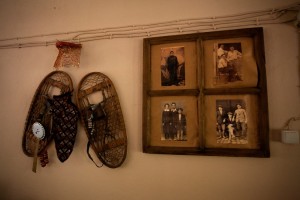 Fortuna Pension "Our elders tell us that we once lived side-by-side with Armenians. We became Muslim and they, Christian. As to what happened before we became Muslim, we don't know," Selçuk says.
Fortuna Pension "Our elders tell us that we once lived side-by-side with Armenians. We became Muslim and they, Christian. As to what happened before we became Muslim, we don't know," Selçuk says. "Have you read anything to find out?"
"Yeah, I've read a number of books and have learnt much," he says but stops. I don't pursue the matter any further.
"Isn't it odd that you speak Turkish, are Sunni Muslims, but consider yourselves to be a separate nationality?"
"It's not odd to us."
"You probably once spoke the Hamshen language, like they do in Hopa."
"According to our elders, we never spoke Armenian or the Hamshen dialect. This is what our grandfathers tell us. We can't go back further than that."
"Do you believe people here once spoke Hamshen?"
"Boughlama" A staple Hamshen dish served as
breakfast at the Fortuna Pension
'The Hamshens indeed had links with Armenians but there's an unfriendly attitude towards Armenians. There's some type of contradiction and I don't know how it started. Why, for example, do the Hopa-Hamshens still speak the language while we have forgotten it? We speak Turkish with a certain accent and use some words that aren't Turkish."
Selçuk gives me some examples of such words that turn out to be mostly Armenian: kaj/kaytz (lightning), kajolik/kaytzorik (firefly) denchkap/glkhashor (headscarf), agos/akos-irrigation furrows in the field; the names of yaylas baghchur (cold water), jermakjur (white water).
The Hamshens have a song in Turkish in which the word akhchik (girl) is used. There are words that I realized were Armenian only after opening a dictionary hedik (snow shoes). From the Malkhasyan dictionary: "hedik-high boots worn to walk in the snow"; "tchougal-pitcher, wine jar". It's probably the word tchouval (large sack)[1] found in the Malkhasayan dictionary where the "g" has changed to "v". There are words that I can't label as Armenian: koukma-water pitcher, gilmor-metal chain to hang pots from. (In the Nor bargirk haykazyan lezvi, are the words gil-kar (stone), gleli-dzgeli.[2] Selçuk also knows that his family name was Chebants. There's also the Mehtesants clan name.
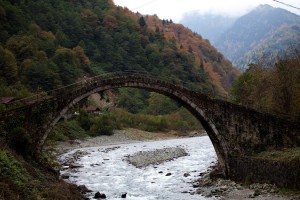 Çinçiva: Bridge from the year 1600 At the back ofUğur Biryol'sbook Kaçkar Mountains, that deals with the geography, towns and villages of Hamshen, there's a dictionary of 588 Armenian and non-Turkish words preserved in the language of Turkish-speaking Hamshens. For example
Çinçiva: Bridge from the year 1600 At the back ofUğur Biryol'sbook Kaçkar Mountains, that deals with the geography, towns and villages of Hamshen, there's a dictionary of 588 Armenian and non-Turkish words preserved in the language of Turkish-speaking Hamshens. For example - Budbudigli (flower patterned cloth), Eğinç/Yeghinj (thistle), Gobit/Kopit (dull, round), Hurç/Khurj (saddle-bag), Kakaçur (farm wastewater), Kargut/Karkut (dry snow), Kec/kaytz (spark), Keduç/ktouts (snout), Keenk/krounk (sock heel), Kokneç/gognots (apron), Macig/madzoun (yoghurt), Meceğh/mzhegh (a type of mosquito), Palul/Barour (swaddling cloth) Sart/sard (spider). As well as the Hopa-Hamshen -word maskatev which is phonetically altered here as Maşkitep, which means "bat".
Returning from emigration in Russia, these Hamshens also brought back with them a number of Russian words that are still used: Istikan (стакан) - glass, Suğhari (сухари) sugar, Peksimet hard biscuit [3]: Thus we see in the Turkish vocabulary of the Bash-Hamshens many Armenian and some Russian words.
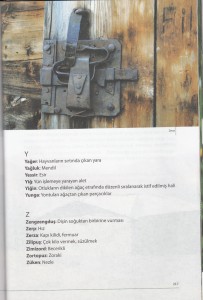 Uğur Biryol: From his book "Let me
Uğur Biryol: From his book "Let me be a cloud in the Kaçkar Mountains"
The Bash-Hamshens still celebrate the holiday of Vardavar (an Armenian Christian holiday with pagan antecedents.
The Bash-Hamshen celebration has been denuded of all religious import and is basically a summer festival up in the mountains). They call it Vardevor.
Selçuk says that in the past the holiday was celebrated with great pomp in the yaylas on the slopes of the Kachkar Mountains.
When sheepherding faded, so did the holiday. "I remember we went up to the yaylas to celebrate Vardavar when I was ten. The people were playing their tulums and dancing.
Today, we still mark the day but the good times of the past are just memories." Selçuk had no clue regarding the origins of Vardavar. (Burials also have an Armenian connection.
The Hamshens bury their dead in coffins, unlike Muslims who only use a shroud.
"If you ask a Hamshentsi what he is, he will answer "Hamshen'. If you then ask what a Hamshen is, he's at a loss. In this country, not calling yourself a Turk is an act of courage," Selçuk says.
The Turkish-speaking Hamshens compensate for this courage with their loathing of Armenians.
Uğur Biryol: In 2004, the reporter
wrote an article entitled "Are the
Hamshens Armenians?" for the
newspaper Agos. "They almost
ran me out of town
(Çamlıhemşin). They called me
a traitor and issued threats."
In 2004, reporter Uğur Biryol wrote an article entitled "Are the Hamshens Armenians?" for the newspaper Agos. He was hounded mercilessly after the article appeared. "They almost ran me out of town (Çamlıhemşin). They called me a traitor and issued threats," says Uğur.
"Someone telephoned from Ankara and said that they wanted to meet with me. We met. The man placed the article in front of me. Turns out this guy was also a Hamshentsi and said that the secret service had given it to him. He urged me not to write anything of the kind, adding, 'And if you want to write, I have a wonderful library for you to use.' I got really scared and told my friends that if something happened to me it's because of the article. Just look how they kicked Hrant Dink."
32 year-old Uğur Biryol was born in Konaklar village (formerly Makrevis) and has authored two books on the Hamshens. The first, Gurbet Pastası: Hemşinliler, Göç ve Pastacılık ("Pastry of Exile: The Hamshens, Migration and Pastry") [Note: Gurbet from the Arabic gharib or exile] tells the story of Hamshen migration and how they became skilled pastry makers.
"The 1900's were economically tough times for the Hamshens just like everywhere else. Tea had not yet entered the marketplace as a commercial commodity. People would grow corn, barley and potatoes, along with raising sheep," Uğur writes in Pastry of Exile.
"People couldn't make a decent living based on this alone. Many Hamshen left for Russia to seek their fortune where the pastry trade was highly developed. The Hamshens decided to work in the sector for three reasons they'd earn money, wouldn't go hungry, and would have a place to stay. They slept right at the job site. Years later, they saved up enough to build some nice homes here. Afterwards, as skilled craftsmen, they branched out to the south. Today, you'll find the grandchildren of those who left for Russia plying their pastry trade in Istanbul and Izmir. Compared to the other peoples of the Black Sea coast, the Hamshens have really seen much of the world beyond."
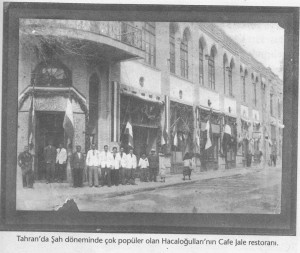 Café Jale: From Biryol's book, Gurbet Pastası:
Café Jale: From Biryol's book, Gurbet Pastası: Hemşinliler, Göç ve Pastacılık ("Pastry
of Exile: The Hamshens, Migration and Pastry")
The book also tells of the links between the Bash-Hamshens and Armenians. Baker Muzaffer Yücel says that they started to migrate by following the Armenians. The Bash-Hamshens mostly left for Russia the Crimea, Batumi and as far as Moscow. He says they later found their way to Poland and Iran. The only pastry shop in Iran belonged to an Armenian. The Hamshens opened another one, the New Day pastry café in 1929. Later it was renamed the Café Jale Restaurant and that's where Yücel worked.[4]
The tradition of pastry making is only found within the Turkish-speaking Hamshen community and not in Hopa.
Sergey Vardanyan cites an 1893 article, "Turkified Armenians", where the author writes that there are Armenians in Rostov, Kharkov and Odessa from the Hamshen district of Rize who have accepted Islam, "who are bread-bakers, cooks and hotel owners. Their last names contain Armenian words Stepan oghli, Hakop ogli, Kostan oghli. They celebrate Vardavar and "they have not yet forgotten the mother language, and if they often speak Turkish, it is because of their fear of government; but, in spite of all, many know and speak Armenian".[5]
So here is the answer to Selçuk's vexing query the Bash-Hamshens were still speaking Armenian at the beginning of the 20th century.
Uwe Bläsing, in his chapter "Armenian in the vocabulary and culture of the Turkish Hemshinli", notes that the presence of a large number of Armenian words retained amongst the western Hamshens indicates that Armenian was spoken in the area even until the beginning and mid-19th century, and can be surmised from travelogues and from information gathered from local residents themselves.[6]
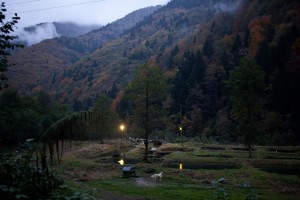 Have the dogs also noted the
Have the dogs also noted the presence of Armenians?
Hovann Simonian believes that the main reason for the disappearance of Armenian, both in Hamshen proper and Karadere, were the pressures exacted by local religious and political authorities. Efforts to revert to Christianity, especially in the region of Karadere (Trebizond) increased during the 1840s and 1850s after the promulgation of the Gülhane edict by Sultan Abdülmecid (18391861) in 1839, which inaugurated an era of reforms (Tanzimat) in the Ottoman Empire, among which was included freedom of religion. Urgent measures to stem apostasy from Islam were soon taken. Turkish schools were opened in the district, where Muslim preachers were also dispatched. According to both T'umayian and Haykuni, a campaign was launched against the use of the Armenian language. Speaking Armenian was declared a sin by mullahs who stated that 'seven Armenian words were an insult for a Muslim'. This campaign was ultimately successful, since within a few generations Armenian had almost died out in Karadere, and by the early twentieth century it was only spoken by elderly people.[7]
"Are there pastry makers in Çamlıhemşin?"
"There's a guy named Kachkar," says Uğur.
"Can we meet him?"
"Such things are risky," explained Uğur, "You can be on the receiving end of something unexpected. They can reject or accept you."
"Why?"
"Things are pretty tense there. You'll be asking questions, taking pictures. They will ask where you are from. When you answer Armenia, it could lead to some unpleasantness. To say, I am Armenian, is problematic," noted Uğur, referring back to the article in Agos and his subsequent wariness.
Thus, during our two day stay in Çamlıhemşin, we only got to speak to Uğur and Selçuk.
We had two days left to spend some time trekking through the pristine river valley cutting and to marvel at how people had built homes perched on the sheer mountain cliffs. We had time to ponder who had built the bridges dating back to the 1600s and to hear the barking of village dogs piercing the silence of nature. Once, surrounded by all this beauty, Khachik turned to me and rhetorically remarked, "And some wonder why Armenians would come here in the first place "
"There are two theses regarding the origins of the Hamshens," Uğur says. "One involves the princedom of Hamam Amatuni and his successors. The other claims something quite the opposite; that the Hamshens are a Turkish tribe that migrated from Central Asia. I believe something else entirely. In the past, Armenians and Turks intermingled and girls were given and taken as brides, resulting in the Hamshen people. We're a mixture of two different cultures. There are Armenians words in the Turkish spoken by Hamshens but they also follow Turkish customs, especially at weddings. I and others like me do not necessarily base our identity on one past or one culture alone. We regard ourselves as humans, first and foremost. Our identity is revealed by living here through our culture. So when I am asked 'what am I?', I graciously respond, 'I am Hamshen'. We say nothing more."
"Do you feel different than the Hopa-Hamshens?"
"Yes, the language of the Hopa-Hamshens makes a world of difference. To maintain their language, Armenian speakers migrated towards Hopa from these parts. The people here couldn't preserve the language. In addition to the language, there are other cultural disparities. They play the kaval and we, the tulum. Even the clothes we wear are different. They dress more simply while we prefer more decorative attire. Our women also wear distinctive headscarves you won't see elsewhere. We also celebrate vardevor; they don't. The topography is also different. Here you'll find chasms and sheer rock cliffs."
In an article about the Hamshen identity, Hagop Hacikian writes that there are two different Hamshen identities, not one that of Rize and Hopa. Beside the geographical division, the language is the primary element differentiating the two groups. The Hopa-Hamshens speak a dialect of western Armenian that is called Homshetsma. The Hamshens of Rize no longer speak the dialect. The Turkish they speak is rich in Armenian vocabulary. The Bash-Hamshens have a greater desire to receive a college education. They have produced many doctors, engineers and teachers, including women. They traditionally work at bread and pastry plants, in hotels and restaurants. The Hopa-Hamshens are mostly engaged in the transportation business, as drivers, etc.
Hacikian writes that by far, the most ardent promoters and propagators of the Turkish origin thesis are the Hemshinli themselves, and they include many rank-and-file people, mostly of the Bash-Hamshen (Rize) group. He cites the following example.
émigré Bash Hamshens
Following the publication of an article in the Istanbul daily Yeni Yüzyıl mentioning that some Hemshinli spoke Armenian, Ali Ihsan Arol, an officer on the board of the Çamlıhemşin and Hemşin foundation, sent a protest letter to the paper. In his letter, Arol argued that 'not every Hemşinli is Armenian' (her Hemşinli Ermeni değil), i.e. that the Hopa Hemshinli perhaps were, but the Bash Hemshinli certainly were not. Arol writes: "It is not true that all Hemshinli have Armenian roots. Yes, there are Hemshinli living in the interior of Hopa speaking the Armenian dialect [sic]. However, it is known that the Hemshinli in Fındıklı, Ardeven, Pazar, Çamlıhemşin, Hemşin and Çayeli are of Turkish descent." [8]
Rüdiger Benninghaus, in turn, cites numerous cases where the Laz and Hamshen accuse each other of having non-Turkish roots. (1989)[9]
According to Hagop Hacikian it is not very clear when the idea of denying Armenian origins and ascribing a fictive Turkish past to the group was conceived, or who authored it. While it is likely that this theory was linked to the Turkish Historical Thesis and was probably conceived in the 1930s, it may have found fertile ground in trends dating back to late Ottoman times. Indeed, according to the writer Atrpet (Sargis Mubayajian), a deterioration in relations between Islamicized Armenians and the ones who remained Christians took place during the final two decades of the nineteenth century. Atrpet accused the Ottoman authorities of having played a key role in this deterioration by mounting Muslims of Armenian background against Armenians. These views of Atrpet, published in the 1929 work Chorokhi Awazanx [The Basin of the Çoruh] (Vienna: Mekhitarist Press), reaffirm those of Sargis Haykuni appearing in an 1895 article in Ararat.[10]
Hopa: City of Fear and Courage
In Hopa, fear and courage go hand in hand and the dilemma this fusion poses is much more pronounced.
In May 2011, when Turkish Prime Minister Recep Tayyip Erdoğan made an election campaign stop in Hopa, residents greeted him with a hail of stones. One person died and several were injured in the ensuing clash with police. More than twenty Hamshen were arrested. After returning to Ankara, Erdoğan remarked, "I didn't know there were bandits in Hopa."
"The next time he comes to Hopa, we'll all carry banners that read 'I am a bandit', just like the banners at Hrant Dink's funeral that read 'I am Armenian'," says a Hamshentsi communist. "They can't keep up in a state of fear any longer."
Another Hopa resident said, "We drive container trucks. We have no fear and don't even apply the brakes on a downhill."
One week before arriving in Hopa, there were clashes between leftists and the cops. It seems that the political tensions will only sharpen in Hopa and surrounding communities.
Then again, I also witnessed the pervading fear in Hopa. I would often be conversing with a Hopa-Hamshens, about the most mundane of issues, and when I reached to pull out my notebook the person would balk, requesting that I not write anything down. 'It's dangerous', they would say, 'I could get into trouble.'
"They took our history from us. The only memory of the Hamshen people is the fear engendered by persecution. It lives on today," Cemil Aksu said.
d
Why I went to Hamshen
My father's father, Avetis Kirakosyan, was a Hamshen. He was born in Trabzon in 1915 and left for Krasnodar to continue his education. He thus survived the massacres and later became a Bolshevik. They executed him in 1937 in Tiflis.
Melkon, the father of Avetis, was a Christian from one of the Hamshen villages. I don't know which one. He sold water on the streets of Trabzon.
My mother would often joke with my dad saying, "Wasn't your grandfather a water-seller?" (My mother's grandfather was a lawyer in Bolis)
The Turks killed Melkon, his wife Azniv, and three of their six children, during the 1915 massacres.
My father had heard story, I don't know from whom, that one day Melkon had obtained a new gramophone.
Cradling it in his arms, he and his friends started the machine up and were returning to his house in high spirits for a party. Suddenly, shots rang out from behind. Melkon's blood dripped onto the record.
Harutyun, my father's uncle, was able to escape the fate of his brother Avetis and father Melkon. He lay beneath the corpses of Armenians executed in 1915.
A Turk found and adopted him; after having circumcised him. A few years later, his brother Avetis found him and took him to Tiflis.
In 1937, it was my father who saved him. One night, in Tiflis, the Cheka, came to the house to take him away. When they knocked on the door, Harutyun wanted to open it but my 15 year-old father didn't let him.
Harutyun figured they would break down the door any way and drag him off, so it was best not to let them just stroll in by opening the door. Luckily, they didn't break it down. Early next morning, Harutyun left for the North Caucasus and safety.
Almast, the sister of my father's father, also survived the Genocide. She had married before 1915 and had left for Sukhumi.
My father Rafayel had Hamshen relatives; children of his father's uncle. They were the Terzyan's, living in the village of Esheri in Abkhazia. During the Soviet era, we had received several packages of apples from them.
In 2004, when I visited Abkhazia to write a travelogue, I tried to locate them but to no avail.
Hamshen expert Hovann Simonian once took a sample from me for his Armenian gene project. It turns out that my genetic group is G1, the same group to which Avik Topchyan, another Hemshin belongs. While I do not know Mr. Topchyan, it would appear that we are in fact related and that generations ago our forbearers were brothers.
I was just a young child when I heard others in the house talk about how there were still Muslim Hamshens living along the Black Sea coast and that they spoke the Hamshen dialect.
Different numbers were tossed about as to how many there were one hundred thousand, one million. Who were these people? Were they actually Armenian? Did they look like us? Were they different, very different? These were the questions racing around in my head. What an exotic thing people who are Muslim but speak Armenian.
I wish to thank the Eurasia Partnership Foundation for its financial grant, without which, the "Armenian Speaking Muslim Hamshens" project wouldn't have been realized.
Khachatur Terteryan assisted in the research work.
Photo by Anahit Hayrapetyan
Translated by Hrant Gadarigian






